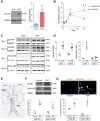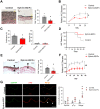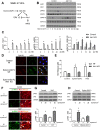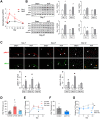Eph-B4 regulates adaptive venous remodeling to improve arteriovenous fistula patency
- PMID: 29133876
- PMCID: PMC5684317
- DOI: 10.1038/s41598-017-13071-2
Eph-B4 regulates adaptive venous remodeling to improve arteriovenous fistula patency
Abstract
Low rates of arteriovenous fistula (AVF) maturation prevent optimal fistula use for hemodialysis; however, the mechanism of venous remodeling in the fistula environment is not well understood. We hypothesized that the embryonic venous determinant Eph-B4 mediates AVF maturation. In human AVF and a mouse aortocaval fistula model, Eph-B4 protein expression increased in the fistula vein; expression of the arterial determinant Ephrin-B2 also increased. Stimulation of Eph-B-mediated signaling with Ephrin-B2/Fc showed improved fistula patency with less wall thickness. Mutagenesis studies showed that tyrosine-774 is critical for Eph-B4 signaling and administration of inactive Eph-B4-Y774F increased fistula wall thickness. Akt1 expression also increased in AVF; Akt1 knockout mice showed reduced fistula diameter and wall thickness. In Akt1 knockout mice, stimulation of Eph-B signaling with Ephrin-B2/Fc showed no effect on remodeling. These results show that AVF maturation is associated with acquisition of dual arteriovenous identity; increased Eph-B activity improves AVF patency. Inhibition of Akt1 function abolishes Eph-B-mediated venous remodeling suggesting that Eph-B4 regulates AVF venous adaptation through an Akt1-mediated mechanism.
Conflict of interest statement
The authors declare that they have no competing interests.
Figures







Similar articles
-
Molecular identity of arteries, veins, and lymphatics.J Vasc Surg. 2019 Jan;69(1):253-262. doi: 10.1016/j.jvs.2018.06.195. Epub 2018 Aug 25. J Vasc Surg. 2019. PMID: 30154011 Free PMC article. Review.
-
Stimulation of Caveolin-1 Signaling Improves Arteriovenous Fistula Patency.Arterioscler Thromb Vasc Biol. 2019 Apr;39(4):754-764. doi: 10.1161/ATVBAHA.119.312417. Arterioscler Thromb Vasc Biol. 2019. PMID: 30786746 Free PMC article.
-
Activation of EphrinB2 Signaling Promotes Adaptive Venous Remodeling in Murine Arteriovenous Fistulae.J Surg Res. 2021 Jun;262:224-239. doi: 10.1016/j.jss.2020.08.071. Epub 2020 Oct 7. J Surg Res. 2021. PMID: 33039109 Free PMC article.
-
Eph-B4 mediates vein graft adaptation by regulation of endothelial nitric oxide synthase.J Vasc Surg. 2017 Jan;65(1):179-189. doi: 10.1016/j.jvs.2015.11.041. Epub 2016 Jan 24. J Vasc Surg. 2017. PMID: 26817610 Free PMC article.
-
Improving the Outcome of Vein Grafts: Should Vascular Surgeons Turn Veins into Arteries?Ann Vasc Dis. 2017 Mar 24;10(1):8-16. doi: 10.3400/avd.ra.17-00008. Epub 2017 Mar 31. Ann Vasc Dis. 2017. PMID: 29034014 Free PMC article. Review.
Cited by
-
Molecular identity of arteries, veins, and lymphatics.J Vasc Surg. 2019 Jan;69(1):253-262. doi: 10.1016/j.jvs.2018.06.195. Epub 2018 Aug 25. J Vasc Surg. 2019. PMID: 30154011 Free PMC article. Review.
-
Sex differences in arterial identity correlate with neointimal hyperplasia after balloon injury.Mol Biol Rep. 2022 Sep;49(9):8301-8315. doi: 10.1007/s11033-022-07644-2. Epub 2022 Jun 17. Mol Biol Rep. 2022. PMID: 35715609 Free PMC article.
-
Distinct subsets of T cells and macrophages impact venous remodeling during arteriovenous fistula maturation.JVS Vasc Sci. 2020;1:207-218. doi: 10.1016/j.jvssci.2020.07.005. Epub 2020 Sep 1. JVS Vasc Sci. 2020. PMID: 33748787 Free PMC article.
-
Sex Differences in Inflammation During Venous Remodeling of Arteriovenous Fistulae.Front Cardiovasc Med. 2021 Jul 21;8:715114. doi: 10.3389/fcvm.2021.715114. eCollection 2021. Front Cardiovasc Med. 2021. PMID: 34368264 Free PMC article. Review.
-
Elastic Laminar Reorganization Occurs with Outward Diameter Expansion during Collateral Artery Growth and Requires Lysyl Oxidase for Stabilization.Cells. 2021 Dec 21;11(1):7. doi: 10.3390/cells11010007. Cells. 2021. PMID: 35011567 Free PMC article.
References
-
- Gibson KD, et al. Vascular access survival and incidence of revisions: a comparison of prosthetic grafts, simple autogenous fistulas, and venous transposition fistulas from the United States Renal Data System Dialysis Morbidity and Mortality Study. J Vasc Surg. 2001;34:694–700. doi: 10.1067/mva.2001.117890. - DOI - PubMed
-
- Besarab A, Ravani P, Spergel LM, Roy-Chaudhury P, Asif A. The native arteriovenous fistula in 2007. Research needs. J Nephrol. 2007;20:668–673. - PubMed
Publication types
MeSH terms
Substances
Grants and funding
LinkOut - more resources
Full Text Sources
Other Literature Sources
Molecular Biology Databases
Research Materials
Miscellaneous

